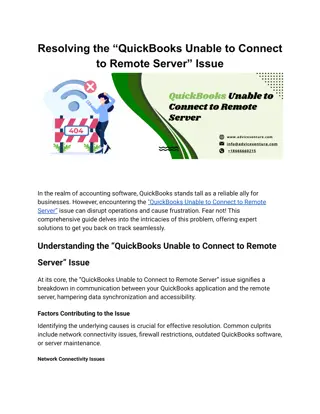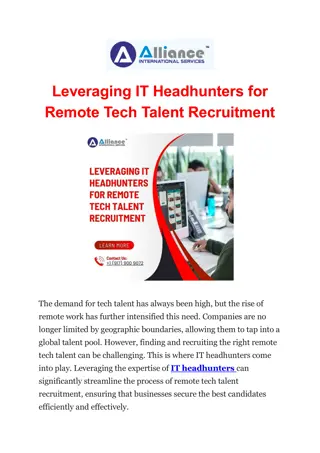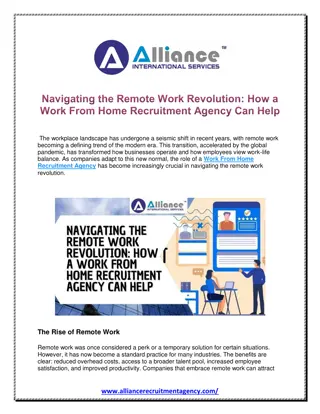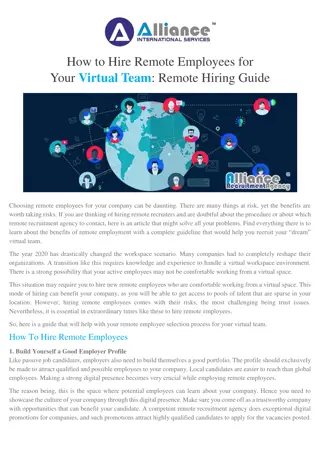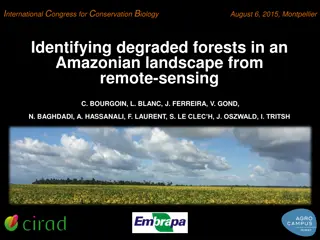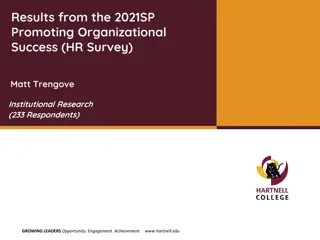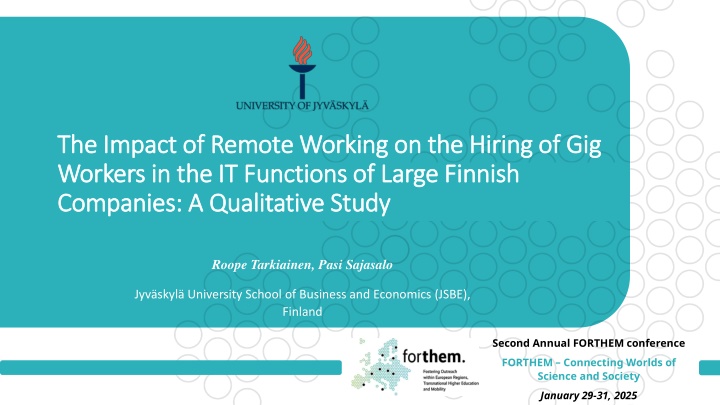
Impact of Remote Working on Hiring Gig Workers in IT Functions of Large Finnish Companies
Explore how remote working influences the hiring of gig workers in IT functions of major Finnish companies. This qualitative study delves into the relationship between remote work and gig work, addressing the gap in current research.
Download Presentation

Please find below an Image/Link to download the presentation.
The content on the website is provided AS IS for your information and personal use only. It may not be sold, licensed, or shared on other websites without obtaining consent from the author. If you encounter any issues during the download, it is possible that the publisher has removed the file from their server.
You are allowed to download the files provided on this website for personal or commercial use, subject to the condition that they are used lawfully. All files are the property of their respective owners.
The content on the website is provided AS IS for your information and personal use only. It may not be sold, licensed, or shared on other websites without obtaining consent from the author.
E N D
Presentation Transcript
The Impact of Remote Working on the Hiring of Gig The Impact of Remote Working on the Hiring of Gig Workers in the IT Functions of Large Finnish Workers in the IT Functions of Large Finnish Companies: A Qualitative Study Companies: A Qualitative Study Roope Tarkiainen, Pasi Sajasalo Jyv skyl University School of Business and Economics (JSBE), Finland Second Annual FORTHEM conference FORTHEM Connecting Worlds of Science and Society January 29-31, 2025
Agenda Background Topic Methodology Results Conclusions Practical Implications Limitations Second Annual FORTHEM conference FORTHEM Connecting Worlds of Science and Society January 29-31, 2025
Background Both gig work and remote work as forms of flexible work have become increasingly prevalent since the mid- 1990s, especially after the Covid-19 pandemic. The prevalence of remote work grew trifold during the Covid-19 pandemic (Adrjan et al., 2021). IT as a field of work has the highest prevalence of remote work and the most investment into remote work- enabling technology per worker (Office for National Statistics, 2020) Gig work has similarly experienced a growing trend since the mid-1990s (e.g. Katz and Krueger, 2018), aided by technological advances, such as digital working platforms (Roy and Shrivastava, 2020), The scarcity of skilled IT workers persists in Europe causing organizations to reach out to the external labor force for the required know-how and skills (Bradbury, 2017), but also due to factors, such as cost benefits (Dokko et al, 2015). As IT work can now be carried out largely remotely, this may impact the hiring of gig workers into IT functions. Existing research does not sufficiently address the nature of the relationship between remote work and gig work, nor its theoretical and practical implications. Second Annual FORTHEM conference FORTHEM Connecting Worlds of Science and Society January 29-31, 2025
Topic Aim: To conduct a qualitative study to address this notable gap in research by exploring how remote working relates to the hiring of gig workers in the IT functions of large companies in Finland. Research question: How does the increase in remote working relate to the hiring of gig work in IT functions of large Finnish companies? Key terminology: Remote work, gig work, IT work, blended organization, digital platforms. Second Annual FORTHEM conference FORTHEM Connecting Worlds of Science and Society January 29-31, 2025
Methodology 1. Forming the propositions via literature review: Proposition 1: Remote work affects the hiring of gig workers in IT functions of large Finnish companies. Proposition 2: Hiring remote gig workers enables IT functions to reduce costs. Proposition 3: Remote work enables IT functions to respond to demand fluctuations by benefitting from the adaptable and scalable nature of gig work. 2. Conducting interviews: Thematic interviews conducted between October 2023 and March 2024. A sample of twenty leaders of the IT functions of large Finnish companies, all within the top 1000 Finnish companies in terms of turnover (Suomen Asiakastieto Oy, 2021) 3. Abductive analysis: Gioia methodology was chosen because it provides qualitative research the needed rigor via its systematic research approach (Magnani and Gioia, 2023). Second Annual FORTHEM conference FORTHEM Connecting Worlds of Science and Society January 29-31, 2025
Results The first proposition Remote work affects the hiring of gig workers in IT functions of large Finnish companies can be assigned partially supported status by our findings. The second proposition, Hiring remote gig workers enables IT functions to reduce costs , can be assigned a fully supported status. Finally, the third proposition Remote work enables IT functions to respond to demand fluctuations by benefitting from the adaptable and scalable nature of gig work can be assigned a mostly supported status. Second Annual FORTHEM conference FORTHEM Connecting Worlds of Science and Society January 29-31, 2025
Conclusions IT decision-makers can benefit from remote working as a tool for enabling the hiring of gig workers, and that remote work prompts a cost reduction and volume adaptation rationale for hiring gig workers. New findings: A surprising new finding within this dimension, deviating from previous research (e.g., Umar et al. 2020), was that remote work does not seem to impact the quantity of gig workers hired. Gig workers are also having more permanent roles in supporting the expansion and growth of the IT functions, calling into question the traditional view in the literature of gig work being comprised of task-based assignments being completed for limited time periods (e.g. Friedman, 2014). Second Annual FORTHEM conference FORTHEM Connecting Worlds of Science and Society January 29-31, 2025
Practical Implications Remote working can be expected to remain a key component of conducting IT work going forward, including playing a role in the hiring of IT gig workers. IT leadership should ensure their in-house staff have the needed digital tools and skills to cooperate with gig workers remotely to realize the benefits sought. The gig workers themselves are expected to need to retain the ability to work remotely effectively to meet their client organizations expectations. Second Annual FORTHEM conference FORTHEM Connecting Worlds of Science and Society January 29-31, 2025
Limitations Did not examine other variables possibly impacting the hiring of gig workers, e.g.: Technical capabilities of the gig workers and the client organizations, Changing financial circumstances of these parties, The possible move to hybrid and on-premises work. The study was conducted within a single country setting, thus implying limited cultural generalizability and a potential for more insight into remote working and gig working. Did not further explore the possible challenges remote working poses for hiring gig workers. Second Annual FORTHEM conference FORTHEM Connecting Worlds of Science and Society January 29-31, 2025
References Adrjan, P., Ciminelli, G., Judes, A., Koelle, M., Schwellnus, C. and Sinclair, T., Will it stay or will it go? Analysing developments in telework during COVID-19 using online job postings data , OECD Productivity Working Papers, 2021-30, OECD Publishing, Paris. Asiakastieto. (2021). Asiakastieto - Top 1000. [online] Available at: https://www.asiakastieto.fi/yritykset/top-listat. Danny Bradbury (2017). The Top IT Jobs Skills In Europe In 2017. Forbes. [online] 31 Jul. Available at: https://www.forbes.com/sites/hpincemea/2017/07/31/the-top-it- jobs-skills-in-europe-in-2017/. Dokko, J., Mumford, M. and Schanzenbach, D. (2015). A Hamilton Project Framing Paper. [online] The Hamilton Project, pp.3 4. Available at: https://www.hamiltonproject.org/wp-content/uploads/2023/01/workers_and_the_online_gig_economy.pdf. Friedman, G. (2014). Workers without employers: Shadow Corporations and the Rise of the Gig Economy. Review of Keynesian Economics, 2(2), pp.171 188. doi: http://dx.doi.org/10.4337/roke.2014.02.03. Katz, L.F. and Krueger, A.B. (2018). The Rise and Nature of Alternative Work Arrangements in the United States, 1995 2015. ILR Review, 72(2), pp.382 416. doi: https://doi.org/10.1177/0019793918820008. Magnani, G. and Gioia, D. (2022). Using the Gioia Methodology in international business and entrepreneurship research. International Business Review, 32(2), p.102097. doi: https://doi.org/10.1016/j.ibusrev.2022.102097. Office for National Statistics (2020). Technology intensity and homeworking in the UK - Office for National Statistics. [online] www.ons.gov.uk. Available at: https://www.ons.gov.uk/employmentandlabourmarket/peopleinwork/employmentandemployeetypes/articles/technologyintensityandhomeworkingintheuk/2020-05- 01. Roy, G. and Shrivastava, A.K. (2020). Future of Gig Economy: Opportunities and Challenges. IMI Konnect, 9(1), pp.14 25. Umar, M., Xu, Y. and Mirza, S.S. (2020). The impact of Covid-19 on Gig economy. Economic Research-Ekonomska Istra ivanja, 34(1), pp.1 13. doi: https://doi.org/10.1080/1331677x.2020.1862688.
Thank you! Thank you! Second Annual FORTHEM conference FORTHEM Connecting Worlds of Science and Society January 29-31, 2025



